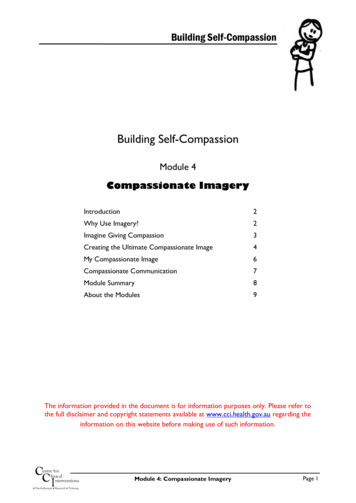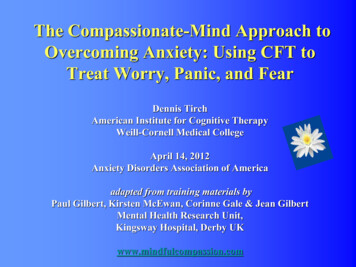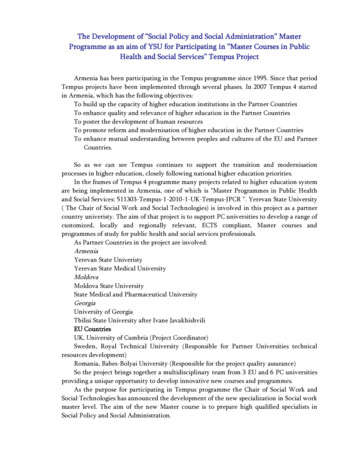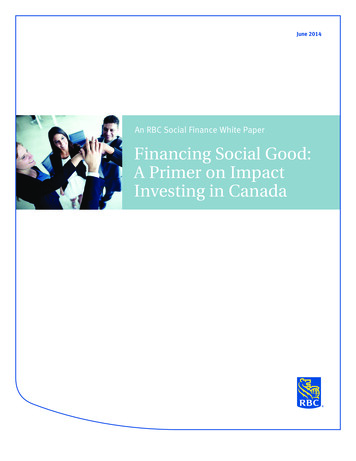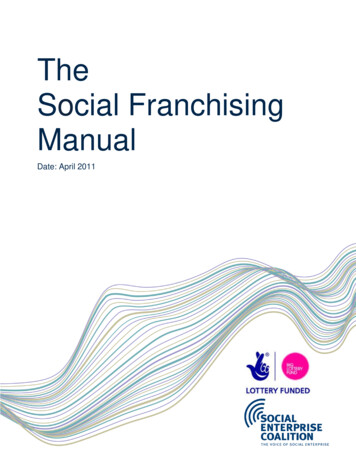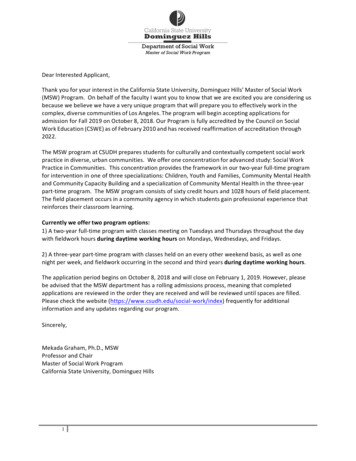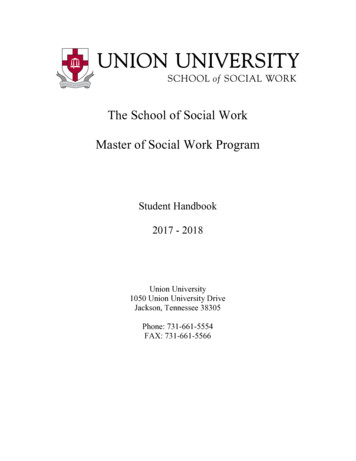
Transcription
Compassionate Social FitnessCompassionate SocialFitness:Theory and PracticeLynne HendersonShyness InstituteApril 14, 2012Anxiety Disorders Association of America 2012, Lynne Henderson1
Compassionate Social FitnessOverviewSocial Fitness Training: Theory and PracticeStanford/Palo Alto shyness clinicCompassion Focused TherapyAdding a compassion focusFor better self-soothingFor shame vulnerable clientsFor therapists who do individual Social Fitness TrainingCompassionate Social Fitness TrainingThe case of JaneBUT! Be prepared . 2012, Lynne Henderson2
Compassionate Social FitnessThree Vicious ther-blameApproachAvoidanceResentment 2012, Lynne Henderson3
Compassionate Social FitnessWhat is Social Fitness?Social Fitness, like physicalfitness, is a state of physiological,behavioral, emotional, andmental conditioning that impliesadaptive functioning and a senseof well being. 2012, Lynne Henderson4
Compassionate Social FitnessSocial Fitness Training 2012, Lynne Henderson5
Compassionate Social FitnessThree Virtuous CyclesFace fearAccept selfAccept othersAccept fearSupport selfSupport othersAct throughemotionAcceptance 2012, Lynne HendersonAccept Efforts Accept others’ effortsSupportForgiveness6
Compassionate Social FitnessCompassion Focused Therapy: GilbertIn order for us to be reassured by a thought (say) ‘I am lovable’this thought needs to link with the emotional experience of‘being lovable’.If the positive affect system for such linkage is not activatedthere is little feeling to the thought.Compassion focused therapy therefore targets the activation ofthe soothing system 2012, Lynne Henderson (with permission, Paul Gilbert)7
Compassionate Social FitnessTypes of Affect Regulator SystemsContent, safe,connectedDrive, excite, vitalityIncentive/resource- focusedNon-wanting/Affiliative focusedSafeness-kindnessSoothingProtection andSafety-seekingActivating/inhibitingAnger, anxiety, disgust 2012, Lynne Henderson (with permission, Paul Gilbert)8
Compassionate Social FitnessBasic Philosophy:CFTWe all just find ourselves here with a brain, emotions andsense of (socially made) self we did not choose but have tofigure out.Life involves dealing with tragedies (threats, losses, diseases,decay, death) and people do the best they can.Much of what goes on in our minds is not of ‘our design’ andnot our fault.We are all in the same boatDe-pathologising and de-labelling – understanding uniquecoping processes 2012, Lynne Henderson (with permission, Paul Gilbert)9
Compassionate Social FitnessThe Need for Compassion in SocialFitness TrainingFor better self-soothing and emotion regulationFor shame vulnerable clientsFor working with individual clients who lack group supportTo add direct interventions to build compassion for the self andothers, to help clients view shyness and shame not aspathology, but as part of human conditionTo add to Mindfulness work (MBSR) – Jon Kabat-ZinnHenderson, L. (2011). Building social confidence using compassionfocused therapy to overcome shyness and social anxiety.Oakland, CA: New Harbinger Publications, Inc. 2012, Lynne Henderson10
Compassionate Social FitnessThree Compassionate CyclesFace fearAccept selfAccept othersAccept fearSupport selfSupport othersAct throughemotionSelf-compassionCompassiontoward othersAcceptanceCompassionForgiveness 2012, Lynne Henderson11
Compassionate Social FitnessJaneBright, attractive young woman in mid-twenties, collegegraduate, living with parentsSevere APD, socially isolated, TV four hours per day, works athome, attends community collegeShy in elementary school, SAD in middle school 2012, Lynne Henderson12
Compassionate Social FitnessCaring-Compassionate MindSKILLS e iourSensoryWarmth 2012, Lynne Henderson (with permission, Paul Gilbert)Warmth13
Compassionate CompassionateSocial Social FitnessFitnessBehavior and cognition: In session exposures with challenging andmodifying unhelpful thoughts; behavioral homework, non-verbalcommunication (SOFTEN; Gabor, 2001)Mindfulness: Body scan, breath meditation,Sensory: Building sensory awareness, locating emotions in bodyDistress tolerance: Expressing emotions, tolerating discomfort (SUDS70 )Attention: Deliberate focusing of attentionImagery: Safe place, perfect nurturer, compassionate ideal self 2012, Lynne Henderson14
Compassionate Social FitnessDoing Better; Feeling WorseShyQ.EOS1-51-7M 4.3M 5.4M 3.5M 3.6Most Difficult: Giving TalkSAQ-Self-blame1–9SAQ-Shame0–4PreM 9.0M 3.2PostM 9.0M 3.2Second most difficult: Conversation with one personSAQ-Self-blame1 – 9 M 9.0M 5.0SAQ-Shame0 – 4 M 2.4M 3.0Third most difficult: Asking a question in classSAQ-Self-blame1 – 9 M 9.0M 5.0SAQ-Shame0 – 4 M 2.4M 3.0 2012, Lynne Henderson15
Compassionate Social FitnessResistance:Fear of CompassionRemember: Compassion focused therapy targets the activationof the soothing system (to gain positive affect) to connectthoughts with the emotional experience referred to by thosethoughts.Compassion can be threatening. Clients can be afraid ofcompassion toward the self, from others and for others.Gilbert, P., McEwen, K., Matos, M., & Rivis, A. (2011). Fears ofcompassion: Development of three self-report measures.Psychology and Psychotherapy: Theory, Research andPractice 84, 239-255. 2012, Lynne Henderson16
Compassionate Social FitnessJane: Fear ofCompassion/SelfExpressing kindness, compassion toward self (rated 4; 0-4)If I really think about being kind and gentle with myself itmakes me sad.I fear that if I start to feel compassion and warmth for myself, Iwill feel overcome with a sense of loss/grief.I fear that if I become too compassionate to myself I will losemy self-criticism and my flaws will show. 2012, Lynne Henderson17
Compassionate Social FitnessJane: Fear of Compassion/OthersResponding to compassion from others (rated 4; 0-4)I’m fearful of becoming dependent because they might notalways be available or willing to give it.If people are friendly and kind I worry they will find outsomething bad about me that will change their mind.When people are kind and compassionate towards me I feelempty and sad. 2012, Lynne Henderson18
Compassionate Social Fitness 2012, Lynne Henderson (with permission, Paul Gilbert)19
Compassionate Social Fitness 2012, Lynne Henderson (with permission, Paul Gilbert)20
Compassionate Social Fitness 2012, Lynne Henderson (with permission, Paul Gilbert)21
Compassionate Social Fitness 2012, Lynne Henderson (with permission, Paul Gilbert)22
Compassionate Social FitnessCountering Resistance toCompassionAcknowledging strengths:Empathy toward her dog, the abandoned student, neighbor,her parents (compassionate sacrifice?)Continuing to build empathy toward her own distress:Continuing to normalize shame, encourage self-disclosure,active listening, reflecting emotions, writing exercises (KristenNeff)Two chair exercises:Protective self and the hopeful, trusting selfSelf critical self and compassionate self-correcting selfCritical self and empathic self (to her own and others’ distress) 2012, Lynne Henderson23
Compassionate Social Fitness 2012, Lynne Henderson (with permission, Paul Gilbert)24
Compassionate Social FitnessThree Compassionate CyclesFace fearAccept selfAccept othersAccept fearSupport selfSupport othersAct throughemotionSelf-compassionCompassiontoward othersAcceptanceCompassionForgiveness 2012, Lynne Henderson25
Compassionate Social FitnessDisclaimer and InformationI have no affiliation with any pharmaceutical company and noneof my work has ever been supported by an outsidecommercial enterprise.Director, Shyness Institute644 Cragmont Ave.,Berkeley, CA 94708Cell: (650) 814-9210Director, Applied ResearchHeroic Imagination Project 2012, Lynne Henderson220 Halleck StreetSan Francisco, CA 9412926
active listening, reflecting emotions, writing exercises (Kristen Neff) Two chair exercises: Protective self and the hopeful, trusting self Self critical self and compassionate self-correcting self Critical self and empathic self (to her own and others’ distress)
